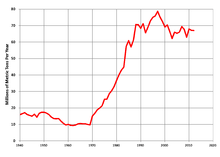Coal in Canada
| Electricity generation in Canada |
|---|
 |

Coal reserves in Canada rank fifth largest in the world (following the former Soviet Union, the United States, the People's Republic of China and Australia) at approximately 10 billion tons, 10% of the world total.[1] This represents more energy than all of the oil and gas in the country combined. The coal industry generates CDN$5 billion annually.[2] Most of Canada's coal mining occurs in the West of the country.[3] British Columbia operates 10 coal mines, Alberta 9, Saskatchewan 3 and New Brunswick one. Nova Scotia operates several small-scale mines, Westray having closed following the 1992 disaster there.[4]
In 2005, Canada produced 67.3 million tons of coal and its consumption was 60 million tons. Of this 56 million tons were used for electricity generation. The remaining 4 million tons was used in the steel, concrete and other industries.[4] The largest consumers of coal in Canada were Alberta and Ontario. In 1997, Alberta accounted for 47% of Canada's coal consumption at 26.2 million tons, and Ontario accounted for 25% at 13.8 million tons. Saskatchewan, Manitoba, Nova Scotia and New Brunswick also use coal to generate electricity to varying degrees.[5]
In 2003, the McGuinty government of Ontario set a goal of closing all coal-fired electricity plants, to be replaced with healthier and more environmentally-friendly energy sources, as it was determined that the long-term health problems caused by coal made it twice as expensive as wind energy.[6][7] The final coal plant in Ontario, Thunder Bay Generating Station, stopped burning coal in April 2014.[8]
Economic impact
In 2012, Pricewaterhouse Coopers released an economic impact analysis of Canada's coal mining industry. According to the report, coal mining made an economic contribution of $5.2 billion to Canada's GDP, including $3.2 billion in direct impacts and $2 billion of indirect impacts, between 2001 and 2010. In 2010, more than 42,000 people were directly and indirectly employed by the coal industry. In 2010 the coal sector accounted for 14% of total mining employment. Average coal industry salaries are more than double the average national wage. Between 2001 and 2010, the value of the coal sector's output grew an average of 14.6 percent each year, and between 2001 and 2011 capital investment in the industry increased at an average rate of 19.3 percent annually. Coal production reached a value of $7 billion in 2011, an increase from $1.6 billion in 2001.[9]
See also
References
- ↑ The Canadian Encyclopedia - Coal
- ↑ Coal in Canada Archived 2008-05-08 at the Wayback Machine.
- ↑ Maps of coal in Canada
- 1 2 National Resources Canada - Coal Archived 2008-05-16 at the Wayback Machine.
- ↑ CBC News on energy in Canada
- ↑ Wilson, Jennifer (25 September 2007), "Ontario's power crunch: What's the answer?", CBC News, retrieved 2010-09-06
- ↑ http://m.theglobeandmail.com/news/national/time-to-lead/cheap-and-dirty-where-provinces-diverge-on-energy-crossroads/article2162021/?service=mobile
- ↑ http://www.opg.com/news-and-media/news-releases/Documents/140415TBGSBurnsLastCoal.pdf
- ↑ "Economic impact analysis of the coal mining industry in Canada" (PDF). Coal Association of Canada / Pricewaterhouse Coopers. October 31, 2012. Retrieved July 20, 2014.